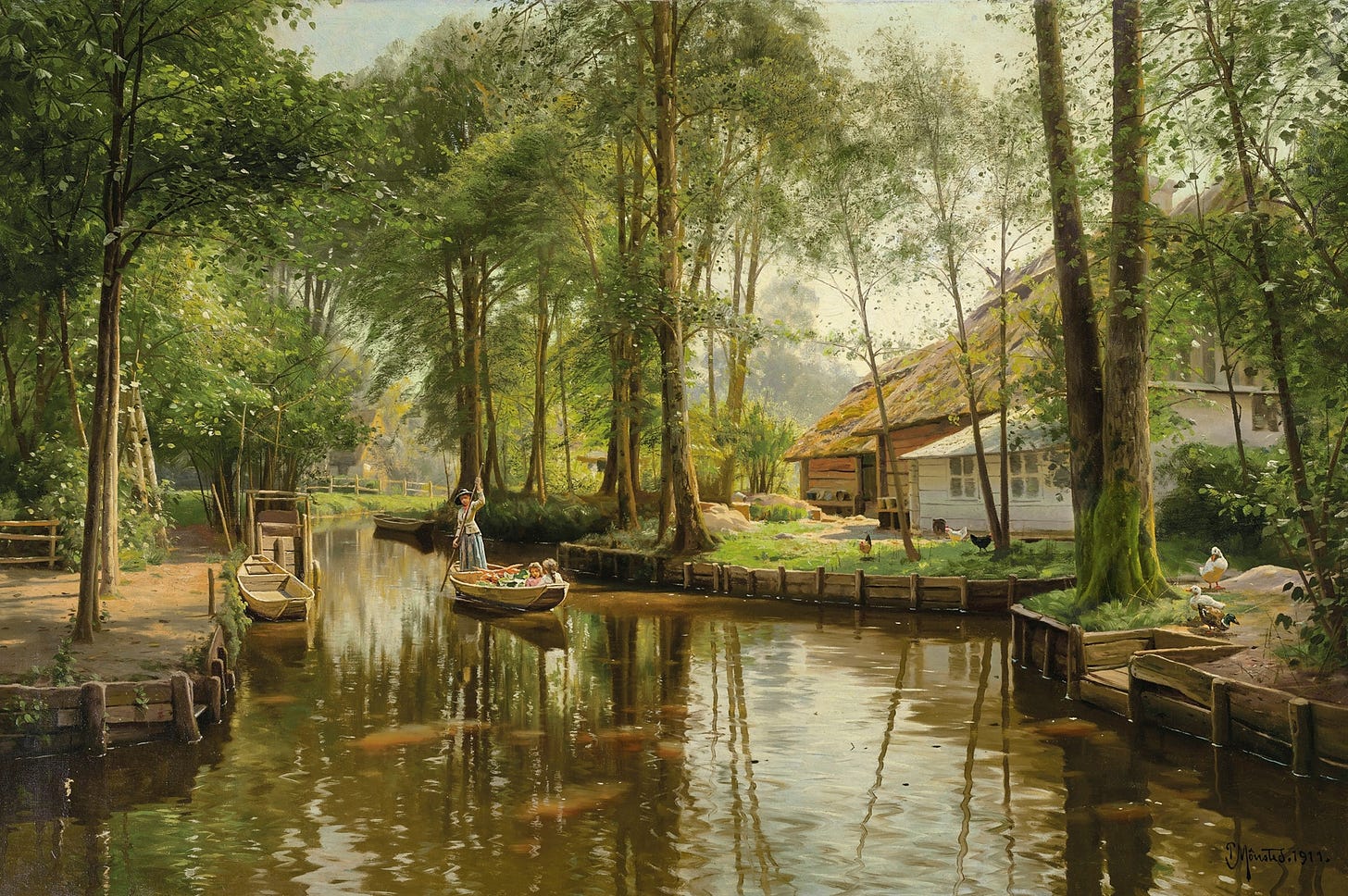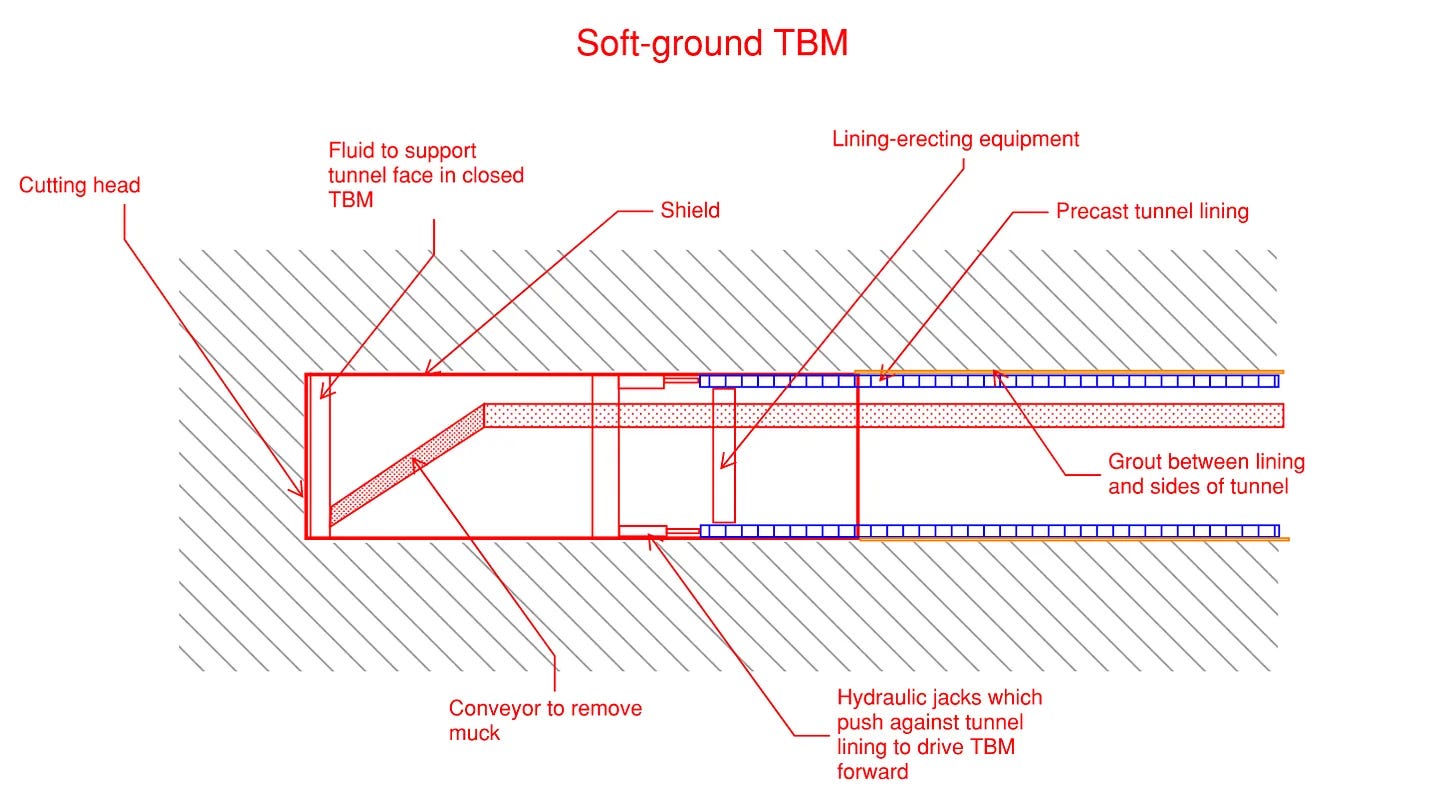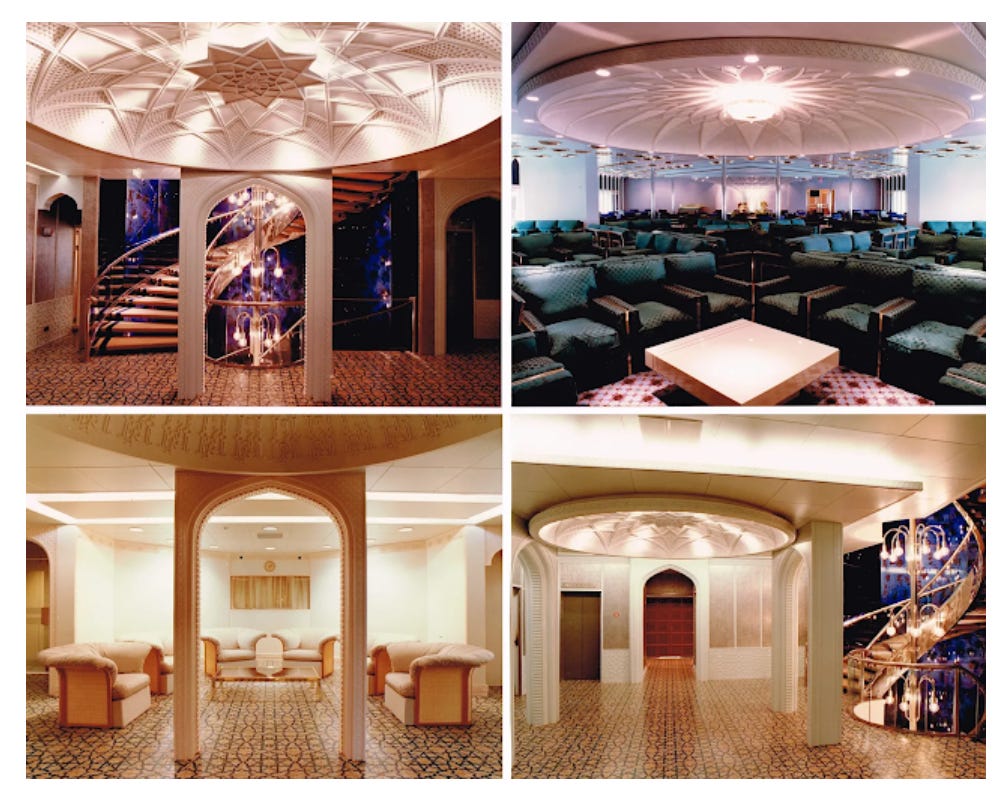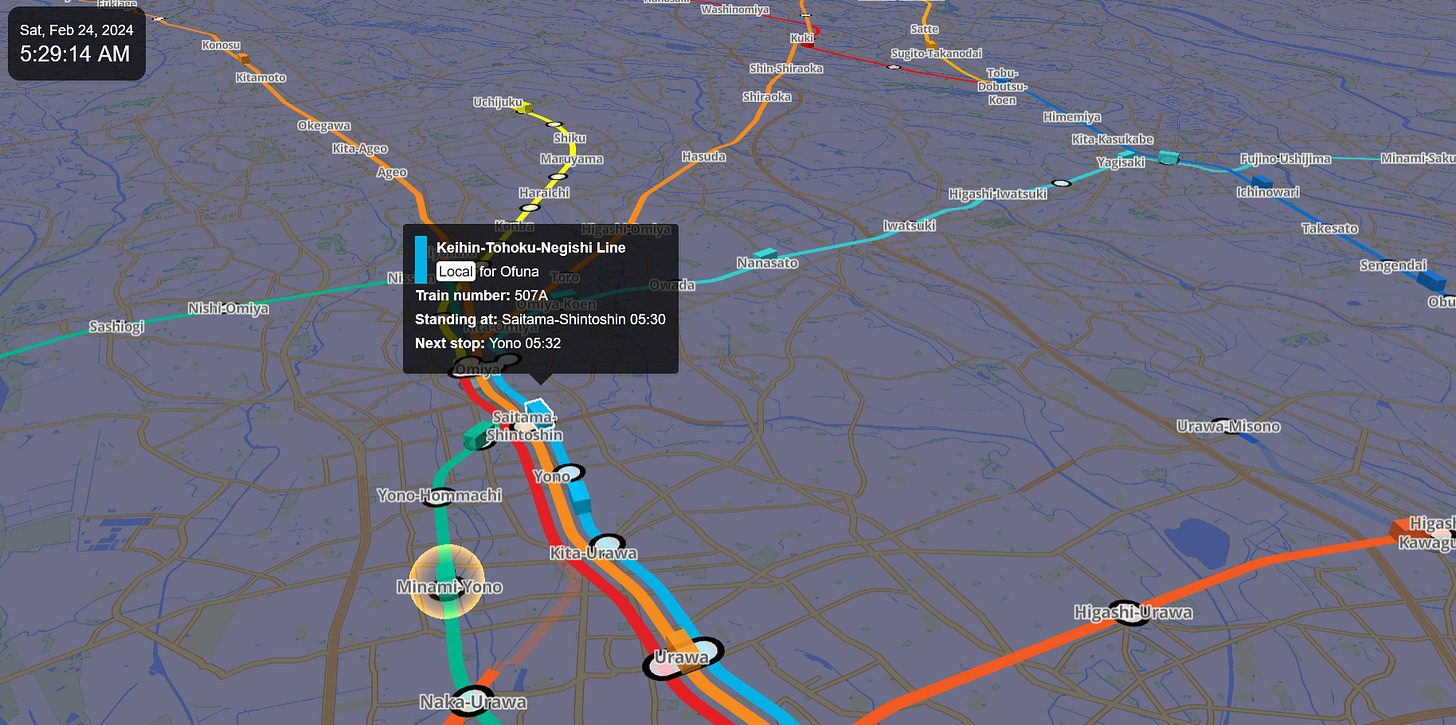Issue #16
The Evolution of Tunnel Boring Machines | The Hidden Cost of Nutrition Misinformation | Nice View. Shame About All The Tourists. | + 4 Bonus Content | Free Resources - Mini Tokyo 3D
Going to Market (1911) by Peder Mørk Mønsted
Source: Artvee
Est. Reading Time: 6 mins
Construction 🏗️
The Evolution of Tunnel Boring Machines
By Construction Physics
Annotations
Source: Construction Physics
The Tunnel Boring Machine (TBM) is an engineering marvel akin to a mobile factory that burrows through the earth and constructs a tunnel behind it. All TBMs share several basic features:
Rotating cutting head: TBMs are mounted with a rotating cutting head at the front which excavates the face of the tunnel.
Conveyor: The excavated material is fed through the openings in the cutting head and works it’s way to the back of the TBM through a conveyor.
Hydraulic cylinders: The TBMs use large hydraulic cylinders to force their way against either the excavated sides of the tunnel or a prefabricated tunnel lining.
Since the 19th century, TBMs have primarily evolved along two paths of technological development- the development of machines for tunnelling through soil and soft ground and machines for tunnelling through rock.
John Price is credited with designing the first successful soft-ground tunnel excavation machine in 1896. The machine was made up of a disc that spun around, with six bucket-like blades affixed to its periphery. These were connected to a cylindrical shield that was 3.86 meters across. As the disc turned, the blades would carve out the earth and direct it onto a conveyor belt for disposal.
In rock tunnelling, the primary problem was building a machine that was strong enough to cut through the rock. While the only alternative to soft ground tunnelling was laborious hand excavation, rock tunnelling had a successful mechanism in the form of drill and blast excavation. It involved workers drilling holes into the face of the tunnel, filling them with explosives and blasting them. As the drill and blast technology improved, there was comparatively less incentive to develop rock tunnelling machines.
James Robbins built the first successful rock tunnelling machine in 1954 for the Oahe Dam project in South Dakota. The uniqueness of Robbins’ machine lay in its disc cutter. The disc cutter operates by being pressed against the rock’s surface, where it rolls freely as the TBM’s head spins, subsequently crushing a thin strip of rock underneath it. The disc cutter remains the standard cutting tool for rock TBMs and is also used on soft-ground TBMs. Today, Robbins is one of the leading manufacturers of all types of TBMs.
Healthcare 🥪
Read This, Not That: The Hidden Cost of Nutrition Misinformation
By Asterisk Magazine
Annotations
Nutrition misinformation is rampant and can be harmful. While misinformation can have multiple definitions, in this context it’s used to denote information that can be factually accurate but lead to incorrect conclusions. For example, while the terms “multigrain” and “wheat” on bread packaging are technically accurate, consumers may be fooled into thinking that they’re buying whole-grain bread when in reality it’s closer to white bread.
The field of nutrition is riddled with challenges:
Nutrition is a complicated field as it lies at the intersection of numerous food properties and many facets of human physiology.
Some of the most significant nutrition-related conditions, like heart disease, can unfold over many years.
It’s difficult to accurately quantify what people eat on a daily basis, including by asking them, as most observational studies do.
More often than not public misinformation emerges as it passes through the bullhorn of academic press releases and popular media. When press releases overstate research findings or provide unproven health advice based on them, it tends to be regurgitated in the news.
Often, popular nutrition books follow a familiar trope of painting scientists, nutrition professionals, and doctors as incompetent, biased, and/or corrupt. By de-legitimizing conventional nutrition authorities, the authors fill the void with their own solutions, which are usually weaker than those they seek to dismiss. This can have a slightly corrosive effect on society as a whole by reducing public trust in scientists, nutrition professionals, and doctors.
To remedy this we need to:
Improve how researchers communicate their findings to journalists, and how journalists communicate science more accurately.
Censure the countless academic journals that don’t meet scientific standards.
Support scientific watchdogs like Retraction Watch.
Culture 🪂
Nice View. Shame About All The Tourists.
By Noēma
Annotations
While tourism is often romanticized, it is equally hated and can be viewed as having colonial undertones. Accounting for 8% of global carbon emissions, tourism has become an embodiment of the Anthropocene. In the most popular tourist places, there’s been growing resistance from locals, destruction of pristine ecosystems, and rising rents, necessitating a hard look at the nature of tourism: who benefits and who gets to participate.
Historically, most human movement was out of compulsion, either due to disaster, scarcity or enslavement. During peace times, travel also meant seeking spiritual enrichment and intellectual stimulation — at least for the affluent.
In the 1930s, progressive lawmakers in the West started to implement laws for paid holiday leave. In 1936, the socialist government of Léon Blum in France granted two weeks of paid vacation. Two years later, Britain enacted the Holidays with Pay Act. Following WWII, the US dedicated billions of dollars to restore Europe’s devastated economy. As part of the Marshall Plan, investments were made in constructing hotels, promoting holidays, and subsidizing air travel.
At the turn of the century, the collapse of the Berlin Wall in 1989 and the East’s tilt towards consumer capitalism, opened up the entire world to the tourist. The number of people taking foreign vacations every year skyrocketed— from 69 million in 1960 to 286 million in 1980 to almost 1.5 billion in 2019.
Soon after its establishment in 1990, the World Travel and Tourism Council (WTTC) commissioned the Wharton School to develop a means of measuring tourism’s economic contribution as a whole. This led to the formulation of the Tourism Satellite Account system (TSA), which combined the economic value of multiple tourist-dependent industries into an aggregate dollar amount. By 2019, as the TSA revealed, tourism accounted for 10.4% of global GDP and 334 million jobs worldwide.
Often, the short nature of vacations and the anonymity of being in a foreign land brings out the worst in tourists. While democratization has made tourism more accessible, it has also accelerated the destruction of local ecosystems and monuments. But what if tourism just stopped? Would the national parks still exist without tourists flocking to see the frightened animals? What is worse: the tourist with a telephoto lens or the poacher with a gun?
Bonus 🎁
An interesting video about the discovery of new celestial objects and the power of citizen volunteers.
The History of Microsoft Encarta
During my childhood, I remember spending countless hours on Encarta, exploring new countries and noting down (scribbling) salient facts about them in my little notepad. It’s an insightful article that shows how the fate of some of the most well-known educational sites - Encyclopedia Britannica, Wikipedia and of course, Encarta were intertwined.
These Were Saddam Hussein’s Crazy Mega Yachts
Source: Oryx
A surprisingly interesting read about the history and current whereabouts of Saddam’s mega yachts.
How AI Is Helping Us Learn About Birds
If you’re a serial bird watcher and a tech enthusiast, this is the perfect article for you.
Free Resources 💡
Source: Mini Tokyo 3D
Mini Tokyo 3D: It’s a map that gathers real-time data from multiple sources to display the movement of public transportation, live web cams, etc.
For more free resources (190+ websites and tools), check out Searching.





